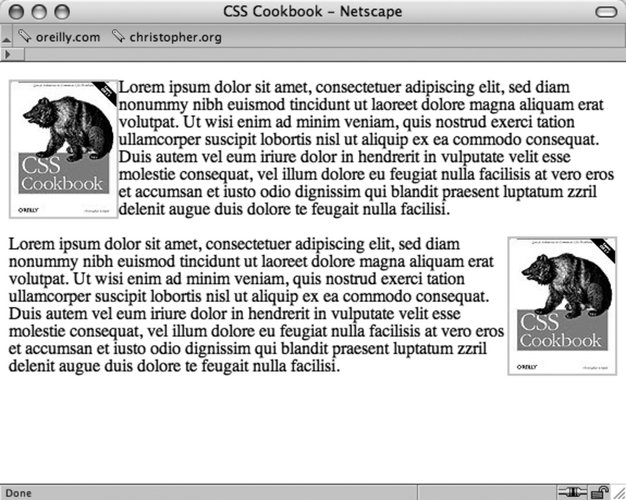Recipe 1.14. Using Floats with Images
ProblemYou want to place an image on the left or the right side with text wrapping around the image instead of appearing above or below the image (see Figure 1-35). Figure 1-35. Images do not wrap around the text by default SolutionFirst create class selectors for the images: .leftFloat { float: left } .rightFloat { float: right }Then add the class selector to the markup and see how it works in Figure 1-36: <img src="/books/3/27/1/html/2/csscookbook.gif" alt="cover" /> <p>This is the book cover for the <em>CSS Cookbook</em>.</p> <img src="/books/3/27/1/html/2/csscookbook.gif" alt="cover" /> <p>This is the book cover for the <em>CSS Cookbook</em>.</p> DiscussionIn the times before there were any compliant standards, designers used the align attribute with the img element to move images to the side with text wrapping. W3C deprecated align and now recommends using float instead. Floats can be used with elements other than images to shift an item left or right within its current place. In Figure 1-36, the second image overlaps with the paragraph referencing the first image. This looks confusing and needs to be fixed. To work around that, use clear: p { clear: left; } Figure 1-36. With float, the text wraps around the images The clear property tells the paragraph to appear after the end of the image flow. At the second img, the clear properties push the image down to the first line after the previous ends. Instead of lining up with the second p element, the image waits for a new line before showing up. See AlsoW3C 2.1 specification on floats at http://www.w3.org/TR/CSS21/visuren.html#floats; Chapter 9 provides three recipes on using float with page columns; and Eric Meyer's CSS/edge covers floats at http://meyerweb.com/eric/css/edge/. |
EAN: 2147483647
Pages: 235